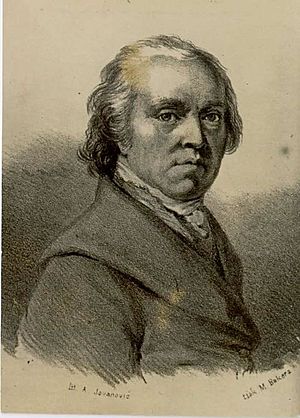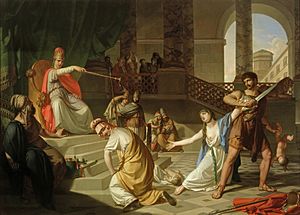Franz Caucig facts for kids
Franz Caucig (also known as Franc Kavčič in Slovene) was a famous painter and artist from the late 1700s and early 1800s. He was born on December 4, 1755, in Gorizia and passed away on November 17, 1828, in Vienna. He was a master of Neoclassicism, an art style that looked back to ancient Greek and Roman art for inspiration. Franz Caucig is considered one of the most important artists of Slovene background from that time. He achieved great success and recognition for his work.
Contents
Life of Franz Caucig
Franz Caucig was born in Gorizia, which was an important city back then. A kind nobleman named Count Guido von Cobenzl noticed Franz's artistic talent when he was 20 years old. The Count helped Franz by sending him to his son, Philipp, in Vienna. Philipp von Cobenzl was a very influential person at the Austrian court, which meant he had a lot of power and connections. He played a big part in helping Franz get an education and start his art career.
Early Art Studies
Franz Caucig first learned about art in Vienna. In 1779, he received a special grant, which was like a scholarship, to study in Bologna and Rome, Italy. He stayed in Rome until 1787, learning from the great artworks there.
From 1787 to 1791, he lived in Vienna again. Then, in 1791, he got another chance to travel. He visited Mantua, Italy, where he especially studied the works of an artist named Giulio Romano. He also copied drawings of ancient sarcophagi, which are stone coffins often decorated with carvings.
Becoming a Professor
From 1791 to 1797, Franz lived in Venice. In 1796, he became a member of the committee at the Accademia di Belle Arti, a famous art academy. He returned to Vienna in 1797. In 1799, he became a professor of drawing at the Vienna Academy. This was a very important position.
In 1810, his mentor, Cobenzl, who had protected him at the Academy, passed away. Prince von Metternich took his place. In 1815, Franz Caucig was offered the job of director for the Painting and Sculpture Class. He didn't accept it right away but finally took the position in 1820. He remained the director until he passed away.
Franz Caucig died from pneumonia on November 17, 1828. This was just four days after his wife also passed away. He was buried in Gloggnitz, a town in Lower Austria. They did not have any children.
Franz Caucig's Artworks
Franz Caucig knew about French Neoclassicism, an art style from France. For example, he saw the famous painting Oath of the Horatii in 1784. However, he was most inspired by the artist Raphael and the School of Bologna, which was a group of painters from Bologna. He also used some dramatic elements from the Baroque art style in his work.
Drawings and Themes
Franz Caucig was a very skilled draughtsman, meaning he was excellent at making drawings. He created over 2,000 drawings! His drawings often showed Italian and Austrian vedute (detailed cityscapes or landscapes). He also drew ancient artworks and pieces by Old Masters (famous artists from earlier times).
His main themes were stories from ancient Greek and Roman times, the Bible, and the lives of Christian saints. Some of his images even showed elements of the Egyptian Revival, which was a style inspired by ancient Egypt.
Painting Style and Message
Caucig's artworks often showed ideas about right and wrong that were based on everyday life, not just religious teachings. This was because of what the people who bought his art wanted. However, he also painted altar pieces for churches and portraits of people. He created over 30 oil paintings.
In line with the art ideas of his time, his paintings had clear lines and a balanced arrangement of objects. The sizes of figures and objects were always correct. He used architectural elements to show space in his paintings. His colors were often cool, and color was less important than the clear lines and shapes.
Today, you can find Franz Caucig's artworks in many places. These include Ljubljana, Vienna, Hungary, Italy, the Czech Republic, Serbia, and the United States.



